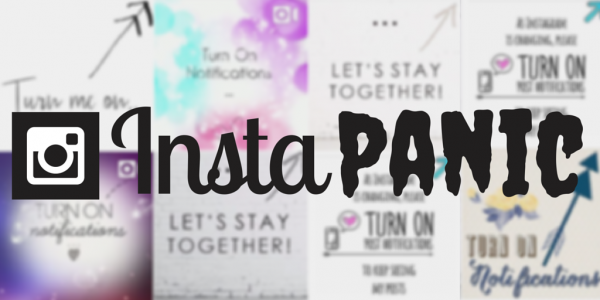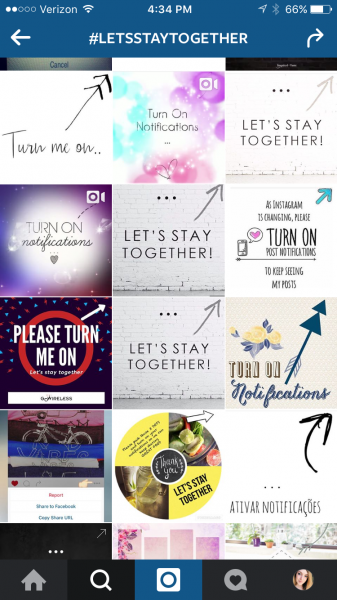 March 29, 2016: On March 28th, Instagram feeds were flooded with “grammers” asking users to turn on their notifications. The hashtag #letsstaytogether began to trend as copycats and marketers hopped on the bandwagon. These posts all pushed back against Instagram’s new feed change, which uses the service’s new smart algorithm to arrange the content of streams (instead of using the time the content posted).
March 29, 2016: On March 28th, Instagram feeds were flooded with “grammers” asking users to turn on their notifications. The hashtag #letsstaytogether began to trend as copycats and marketers hopped on the bandwagon. These posts all pushed back against Instagram’s new feed change, which uses the service’s new smart algorithm to arrange the content of streams (instead of using the time the content posted).
Many, it seems, were confused about the timing of this change, with some posts stating that the change would happen on March 29th. The confusion prompted Instagram to release a statement to The FADER on March 28th saying, “This is not being implemented tomorrow—we still have weeks, or even months, of testing to go. Currently the test groups are very small. When we roll it out broadly, we will definitely let the community know.”

#LetsStayTogether had 17,195 posts as of this screengrab.
Why the panic?
Instagram has stood out as a visual-heavy platform for more creative brands, with high engagement and loyal followings. While Instagram only recently became a player in paid ads, its move to algorithmically-driven feeds is a move in the monetization direction.
Putting a robot in command of Instagram feeds is deeply upsetting to many users because it means that only posts with high levels of approvals will be seen by more than a fraction of people. The change is eerily similar to the one put into effect by Facebook (Instagram’s owner) several years ago when it cut organic reach from 16 to 2 percent.
As we’ve noted previously, there’s little question that Instagram’s new system will force brands and influencers to compete with one another, and also encourage bigger spend on paid ads. And like just about every big change we see coming from the platforms, the burden will likely fall more heavily on smaller brands than large ones with big paid media budgets and robust content marketing strategies.
What can marketers do?
Getting attention on Instagram just got a lot harder. But Instagram’s recent change shouldn’t send anyone – even marketers operating on a shoestring – into full panic mode, and it shouldn’t discourage you from using Instagram at all.
What it does mean is that you’ll need a content marketing and social strategy if you want to win on the platform. Here are a few questions you should ask yourself before continuing with Instagram:
- What demographic are you seeking to reach? Instagram skews younger and is mainly mobile-based, so you may not be reaching the audience you want. On the other hand, if your desired demographic is native to Instagram, maybe it’s worth carving out a modest paid media budget to reach them.
- Are you producing creative content daily? If you don’t have many images and graphics to post, your Instagram presence may become overwhelmed. If your team (or agency) doesn’t have a creative person dedicated to producing content, your account isn’t going to attract many loyal followers. Your posts should also vary in content—posting the same product image over and over again isn’t going to cut it.
- Are your competitors on Instagram? Is your industry suitable for Instagram? There’s a casual mood to this network, and it may not be suitable for very straight-laced business (unless you’re producing really great internal culture content). On the other hand, if your competitors are carving out a niche on Instagram, you’ll have no choice but to counter them.
- Can you commit to spending time on social? This goes for all social media: it’s a full-time job. If you’re not willing to spend the time posting and engaging users, it doesn’t really make sense for you to be there. Many small businesses don’t want to experiment with social, and those are the businesses that will feel the algorithm changes. Sticking to the same themed posts every week will not engage new audiences, and your time will be wasted.
- 10 Mistakes to Avoid When Using QR Codes for Marketing - September 20, 2023
- Kevin Lee on How AI Changes the SEO Landscape - August 31, 2023
- The Power of Compound Marketing: Kevin Lee Presents @ 1MediaWorld 2023 Global Conference - March 7, 2023
